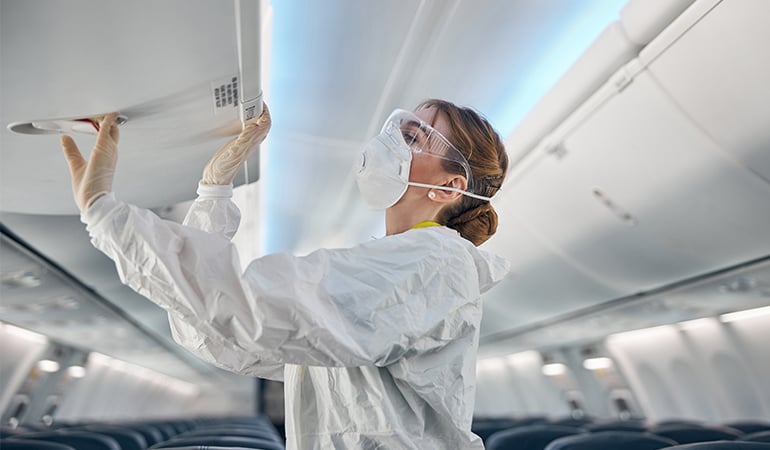The world is now a year into the grips of the COVID-19 pandemic, which has deeply impacted all facets of life. Perhaps no other industry has been harder hit overall than the aviation industry, particularly the airline industry. Airlines fell very hard last spring and have had some difficulty recovering since. Perhaps the most frustrating and challenging component to the travel crash has been the unpredictability of how governments will react. Sometimes, neighboring countries and states have radically different travel rules despite very similar demographics and salient characteristics. As we pass the anniversary, let's take a look at where things stand right now in commercial aviation.
How Covid-19 hit Airlines
The airlines are the prominent movers and shakers; they represent big money in aviation. They were also the hardest hit in the downturn. Where cargo airlines gained as a result of much of the world’s commerce going online, commercial airlines continuously nosedived throughout the past twelve months. Let's take a look at where the major legacy carriers currently stand about a year ago:
American Airlines
By size of the fleet, American Airlines is the world's largest airline and one of the largest in passenger enplanements with around 200 million annually, averaging somewhere in the ballpark of half-a-million passengers per day. Well, that is until early 2020.
On March 20th of 2020, the first severe dip occurred, with AALs stock value dropping almost 65% from where it had been just one month prior. Things started to look up in June as much of the world was probably anticipating a return to normal. However, this would not be the case, and AAL would take another tumble which would be the case for the rest of the summer. In fact, things would not really start to improve until late November, when AAL began a slow but relatively steady climb to its current position at around $21.50. This puts them up about 3.5% on the one-year graph, but they are still down over 20% in the five years. They have a way to go to get back to pre-pandemic status.
Lufthansa
By revenue, Lufthansa is number three in the world. By passengers, they come in slightly lower at seven but still very respectable. As with all airlines, 2020 struck the European market very hard, with travel being all but ultimately curtailed. Lufthansa dipped precipitously, bottoming out on April 24th. Unlike the major American carriers, though, Lufthansa has struggled to regroup. In fact, after taking a €6.7b hit in 2020, Lufthansa has announced that they will be permanently grounding swaths of their fleet. They will be phasing out a significant portion of their fleet, with a grand total of 115 aircraft being parked. For example, their A380 fleet will be retired, with Boeing 747-800s being their sole superjumbo jet. They will be retiring their 744s, their 772s, and A346s. They will be condensing their fleet into a more agile force by exiting aircraft, which are becoming outdated anyway; this just may have proven to provide the impetus to do so.
It has not been all bad for Lufthansa, though; their cargo division has been booming. In fact, in a topic we will discuss later in this article, air cargo continues to boom even though less freight has been moved. But more on that topic later.
China Southern
China Southern is Asia's largest airline and in the top 10 globally by all metrics commonly measured. China was the first country to be afflicted by the COVID-19 virus and largely considered its origin. Accordingly, it was the first airline market to do the downturn because of it.
According to FlightGlobal, China Southern has been hit with a 37% decline 2020 from 2019. This is nothing singular to China; most of the world has been slapped by government-imposed travel restrictions, which have ultimately trickled down to the air travelers themselves.
According to Bloomberg, travel at the end of January 2021, ticket booking was down 71% from the first day of travel in 2020. This was not specific to any one airline but to the entire transportation industry, including rail travel and bus. Airlines in the region are desperate to stoke some interest in air travel, offer some domestic tickets for less than $20, but Chinese travelers are proving to be very reserved and content to stay put for a while.
Despite the Chinese travel market's woes, China Southern is financially bouncing back and is actually up a little over 7% on the one-year graph from last March.
Cargo Airlines and Air Freight
This animal is a little bit tougher to dissect because it is not just looking at cargo airlines vice commercial passenger services. This means that we cannot just look at the major air freight haulers to determine what the overall air freight picture looks like, nor can we ignore cargo airlines' growth and success over the last year.
Dedicated cargo airlines have been largely thriving, but air freight as a whole is still down because commercial passenger airlines, which also carry cargo on the jets, are still down. So overall, net air freight is still down.
FedEx
Undisputedly the world's largest airfreight carrier, FedEx has a fleet of over 400 heavy freighters, composed largely of Airbus A300s, MD10s, and MD11s, and Boeing 757s, 767s, and 77s. They also operate a fleet of contracted regional aircraft, which numbers almost 300 in itself. FedEx is the largest air carrier by tonnage by a wide margin, and they are ninth in the world in fleet size.
Back on March 13th, around the time that the world stood still, FedEx did indeed take a steep topple. But since March, FedEx has been zooming, hitting a 5-year high in December. They have tapered off a little bit, but they are still hovering right around that 5-year high mark. More remarkably, as so much of global trade has suffered, FedEx is up nearly 125% on the year!
United Parcel Service (UPS)
While easily bested by goliath FedEx, the easily recognizable brown freighter is still the second-largest freight hauling air carrier in North America and is easily in the Top 5 globally (#3 most recently, behind giant Qatar Airways Cargo).
UPS is actually in even more enviable of a position than FedEx in terms of value; they initially dipped last March like everyone else in the industry (and world), but it has been nothing but gains since then. They are presently up over 75% on the year, and on the five-year graph, they are up almost 64%, although this doesn't tell the whole story.
Over the past five years, UPS has roughly flown an even keel. However, after a dip in March of last year, which was shared across the world, UPS value has soared, far above anything seen over the previous four years. The heavy shift away from brick-and-mortar commerce and to online e-commerce has turned heavily in favor of air freighters, namely UPS.
How does Covid affect Private Jets and Air Charter?
You don't need to dig deep into the annals of aviation reports to determine that the global COVID-19 pandemic has created an unprecedented boom for private jet travel. The news covering this spike has been covered on mainstream media as far and wide as MSN, CNN, The Guardian, and many, many more.
Distinguished flyers who would have once simply flown first class are edging towards private jets for a few important reasons. First, they are available. Commercial air travel is unpredictable and has been so for a year now. Second, private jets can operate out of many more accessible entry points than airlines that are locked into hubs and routes. A private jet can work where the charter needs it to. Third, private jets are servicing a small base of clientele, and the aircraft are small, making it simpler to sanitize and disinfect the plane.
Another reason for the spike in popularity of private aircraft has been for the wealthy-class to evade short-notice COVID lockdowns. Since private jets can be had on very short notice, it is an effective way to get away from locked-down areas in almost no time with much less competition.
The Big Picture of Recovery
After a year like no other has passed, we now have a much clearer view of what the aviation industry is likely to look like going forward. While this is going to be a fairly broad image, we can assume a few things:
- Commercial air carriers will recover, although it is slow. The weaker airlines may die off or do as Lufthansa and trim the fat. Legacy carriers will continue to be bailed out by their world governments, as they have been until they are back on their feet.
- Airfreight does not appear to be at any real risk of slowing down and will probably continue to boom well into the future. Even though governments are easing off on lockdowns, the way people purchase has changed, and they will continue to seek out e-commerce solutions.
- As long as any credible threat of lockdowns persists, private jet travel will continue to gain traction with the wealthy for the foreseeable future. Also, those who would have traveled first class in the past may very well trade that in and fly exclusively on private jets in the future.
Conclusion to Covid’s effects on commercial aviation
One year after the global pandemic due to COVID-19 was announced, the world is a gravely different place. Yes, many of the dormant airliners taking up ramp space around the world have moved on, some going back into service, but others were permanently retired to save cash. Due to an explosion of air freight growth, some wide-body jets that would have been retired have instead been purchased by air freight and logistics tycoons and retrofitted as freighters. Private jet travel is booming and probably will continue to do so in the foreseeable future. So, in short, the future is a mixed bag, and only time will tell, but certainly, air travel and logistics will not sit out forever; there will continue to be a demand for pilots, technicians, and support equipment for the fleets.
You want to stay updated on our latest aviation news – both Corona-related and not? Subscribe to our blog for free and be the first to read our future articles!



Comments